Investment and Portfolio
VerifiedAdded on 2023/01/18
|13
|2869
|69
AI Summary
This report aims to understand the characteristics of ETF and stock, and the advantages and disadvantages of both from an investor perspective.
Contribute Materials
Your contribution can guide someone’s learning journey. Share your
documents today.
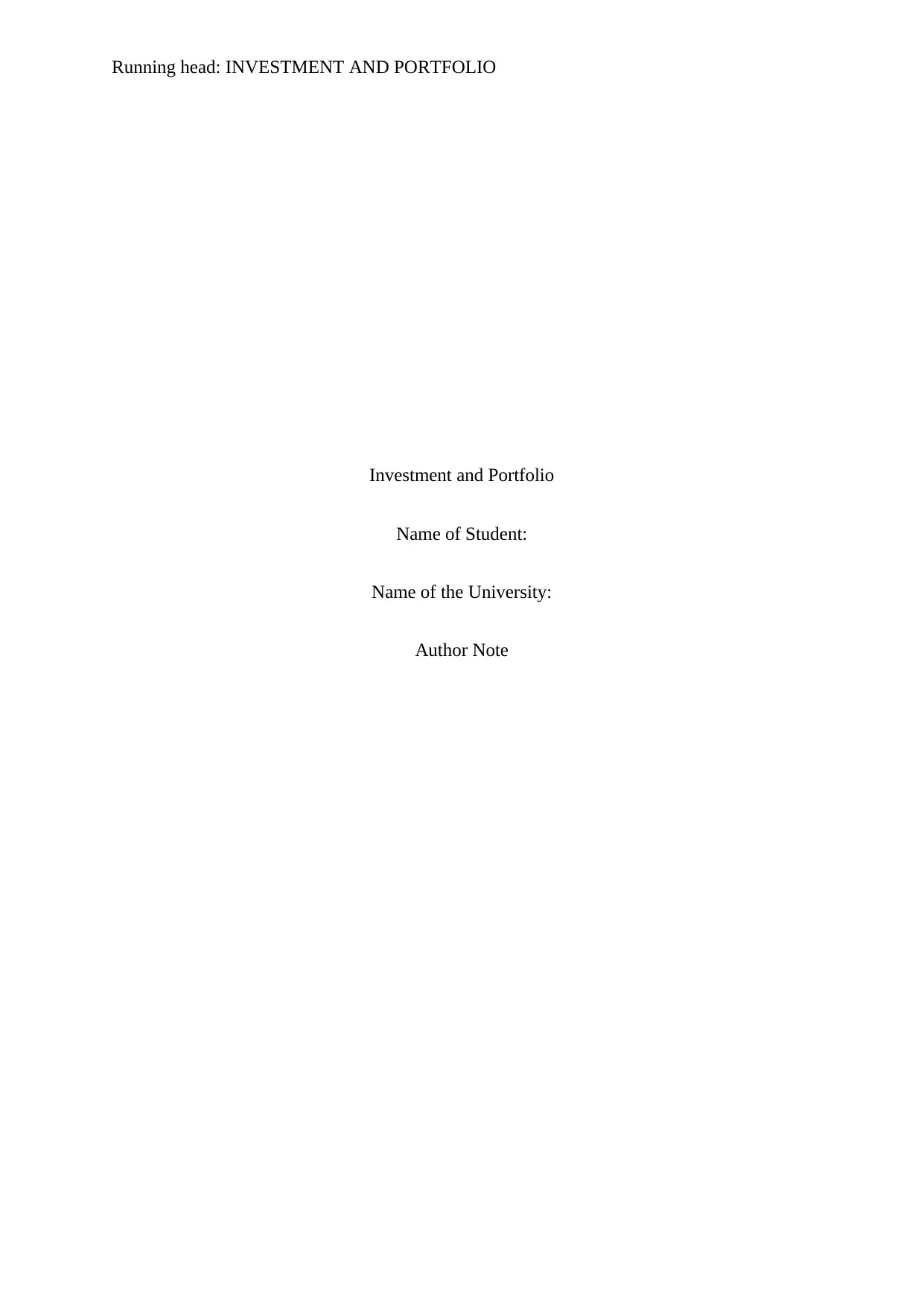
Running head: INVESTMENT AND PORTFOLIO
Investment and Portfolio
Name of Student:
Name of the University:
Author Note
Investment and Portfolio
Name of Student:
Name of the University:
Author Note
Secure Best Marks with AI Grader
Need help grading? Try our AI Grader for instant feedback on your assignments.
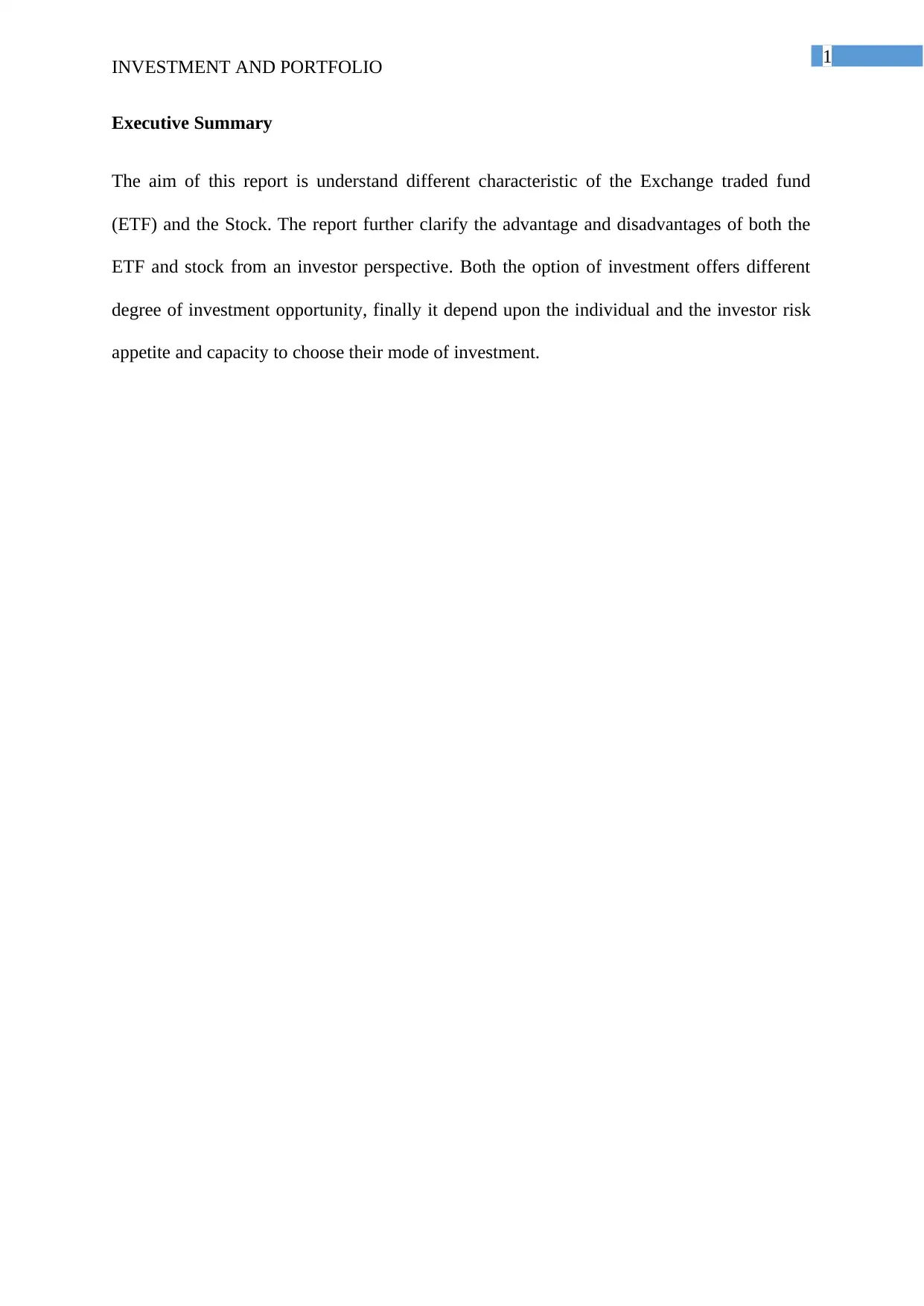
1
INVESTMENT AND PORTFOLIO
Executive Summary
The aim of this report is understand different characteristic of the Exchange traded fund
(ETF) and the Stock. The report further clarify the advantage and disadvantages of both the
ETF and stock from an investor perspective. Both the option of investment offers different
degree of investment opportunity, finally it depend upon the individual and the investor risk
appetite and capacity to choose their mode of investment.
INVESTMENT AND PORTFOLIO
Executive Summary
The aim of this report is understand different characteristic of the Exchange traded fund
(ETF) and the Stock. The report further clarify the advantage and disadvantages of both the
ETF and stock from an investor perspective. Both the option of investment offers different
degree of investment opportunity, finally it depend upon the individual and the investor risk
appetite and capacity to choose their mode of investment.
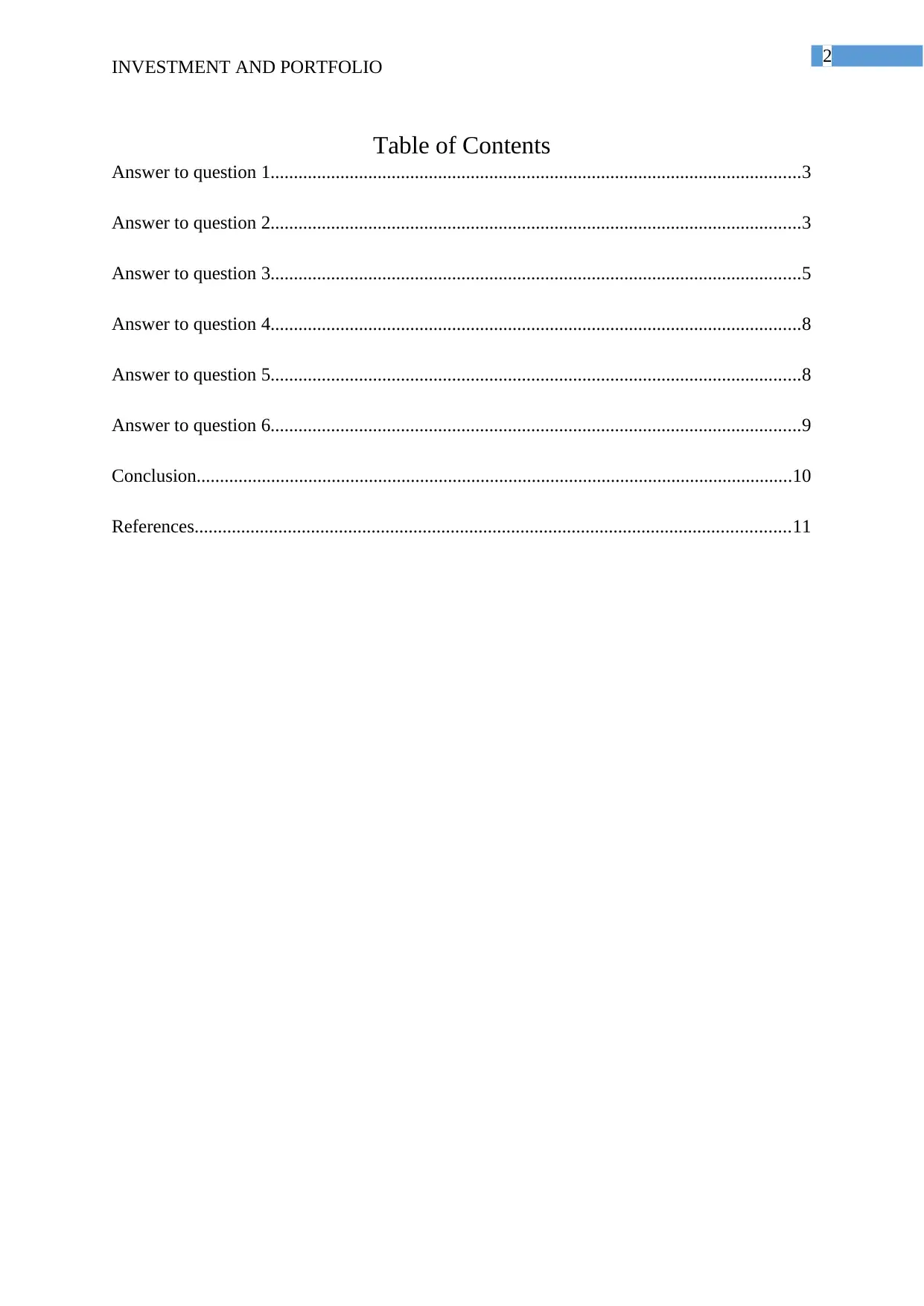
2
INVESTMENT AND PORTFOLIO
Table of Contents
Answer to question 1..................................................................................................................3
Answer to question 2..................................................................................................................3
Answer to question 3..................................................................................................................5
Answer to question 4..................................................................................................................8
Answer to question 5..................................................................................................................8
Answer to question 6..................................................................................................................9
Conclusion................................................................................................................................10
References................................................................................................................................11
INVESTMENT AND PORTFOLIO
Table of Contents
Answer to question 1..................................................................................................................3
Answer to question 2..................................................................................................................3
Answer to question 3..................................................................................................................5
Answer to question 4..................................................................................................................8
Answer to question 5..................................................................................................................8
Answer to question 6..................................................................................................................9
Conclusion................................................................................................................................10
References................................................................................................................................11
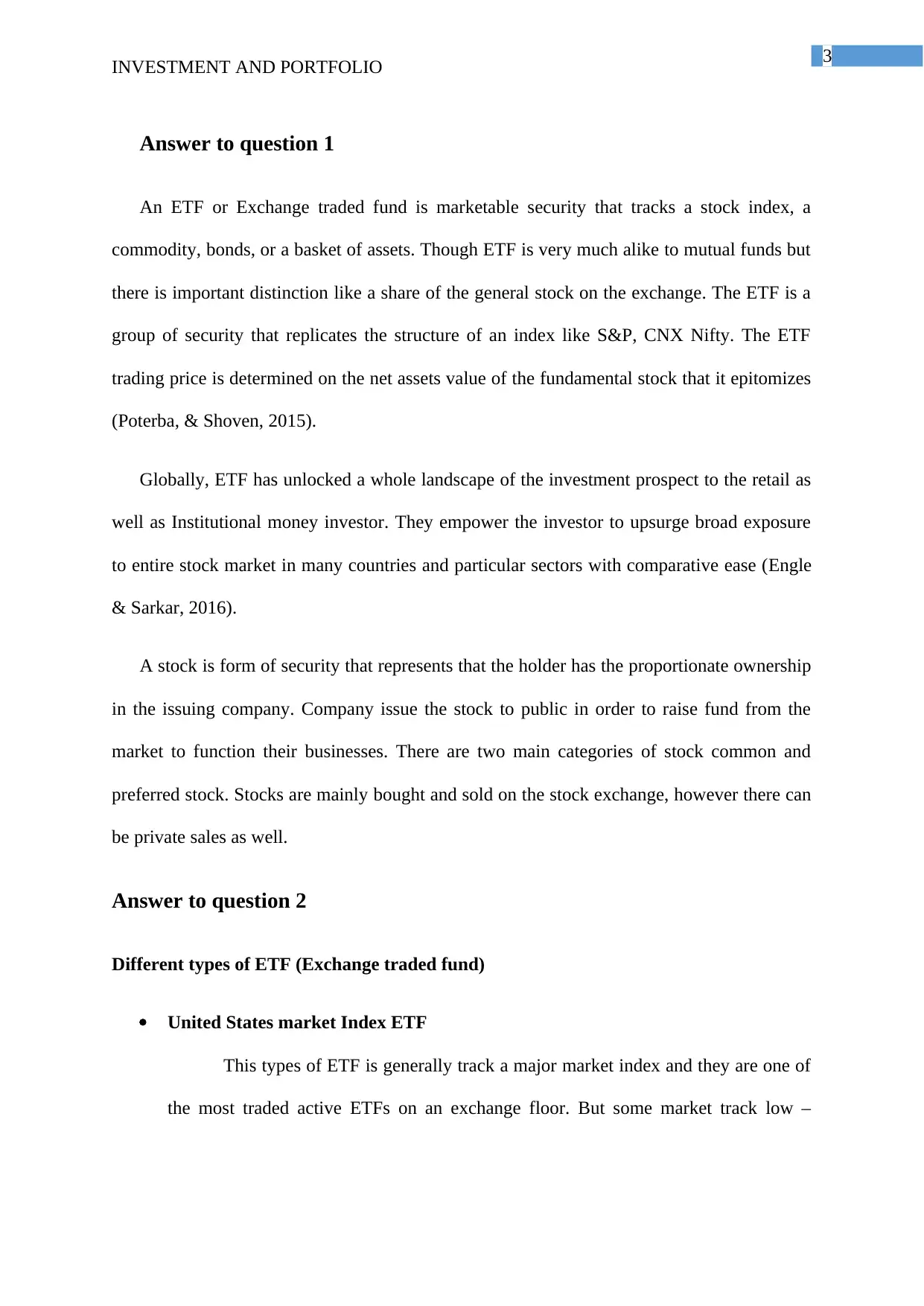
3
INVESTMENT AND PORTFOLIO
Answer to question 1
An ETF or Exchange traded fund is marketable security that tracks a stock index, a
commodity, bonds, or a basket of assets. Though ETF is very much alike to mutual funds but
there is important distinction like a share of the general stock on the exchange. The ETF is a
group of security that replicates the structure of an index like S&P, CNX Nifty. The ETF
trading price is determined on the net assets value of the fundamental stock that it epitomizes
(Poterba, & Shoven, 2015).
Globally, ETF has unlocked a whole landscape of the investment prospect to the retail as
well as Institutional money investor. They empower the investor to upsurge broad exposure
to entire stock market in many countries and particular sectors with comparative ease (Engle
& Sarkar, 2016).
A stock is form of security that represents that the holder has the proportionate ownership
in the issuing company. Company issue the stock to public in order to raise fund from the
market to function their businesses. There are two main categories of stock common and
preferred stock. Stocks are mainly bought and sold on the stock exchange, however there can
be private sales as well.
Answer to question 2
Different types of ETF (Exchange traded fund)
United States market Index ETF
This types of ETF is generally track a major market index and they are one of
the most traded active ETFs on an exchange floor. But some market track low –
INVESTMENT AND PORTFOLIO
Answer to question 1
An ETF or Exchange traded fund is marketable security that tracks a stock index, a
commodity, bonds, or a basket of assets. Though ETF is very much alike to mutual funds but
there is important distinction like a share of the general stock on the exchange. The ETF is a
group of security that replicates the structure of an index like S&P, CNX Nifty. The ETF
trading price is determined on the net assets value of the fundamental stock that it epitomizes
(Poterba, & Shoven, 2015).
Globally, ETF has unlocked a whole landscape of the investment prospect to the retail as
well as Institutional money investor. They empower the investor to upsurge broad exposure
to entire stock market in many countries and particular sectors with comparative ease (Engle
& Sarkar, 2016).
A stock is form of security that represents that the holder has the proportionate ownership
in the issuing company. Company issue the stock to public in order to raise fund from the
market to function their businesses. There are two main categories of stock common and
preferred stock. Stocks are mainly bought and sold on the stock exchange, however there can
be private sales as well.
Answer to question 2
Different types of ETF (Exchange traded fund)
United States market Index ETF
This types of ETF is generally track a major market index and they are one of
the most traded active ETFs on an exchange floor. But some market track low –
Secure Best Marks with AI Grader
Need help grading? Try our AI Grader for instant feedback on your assignments.
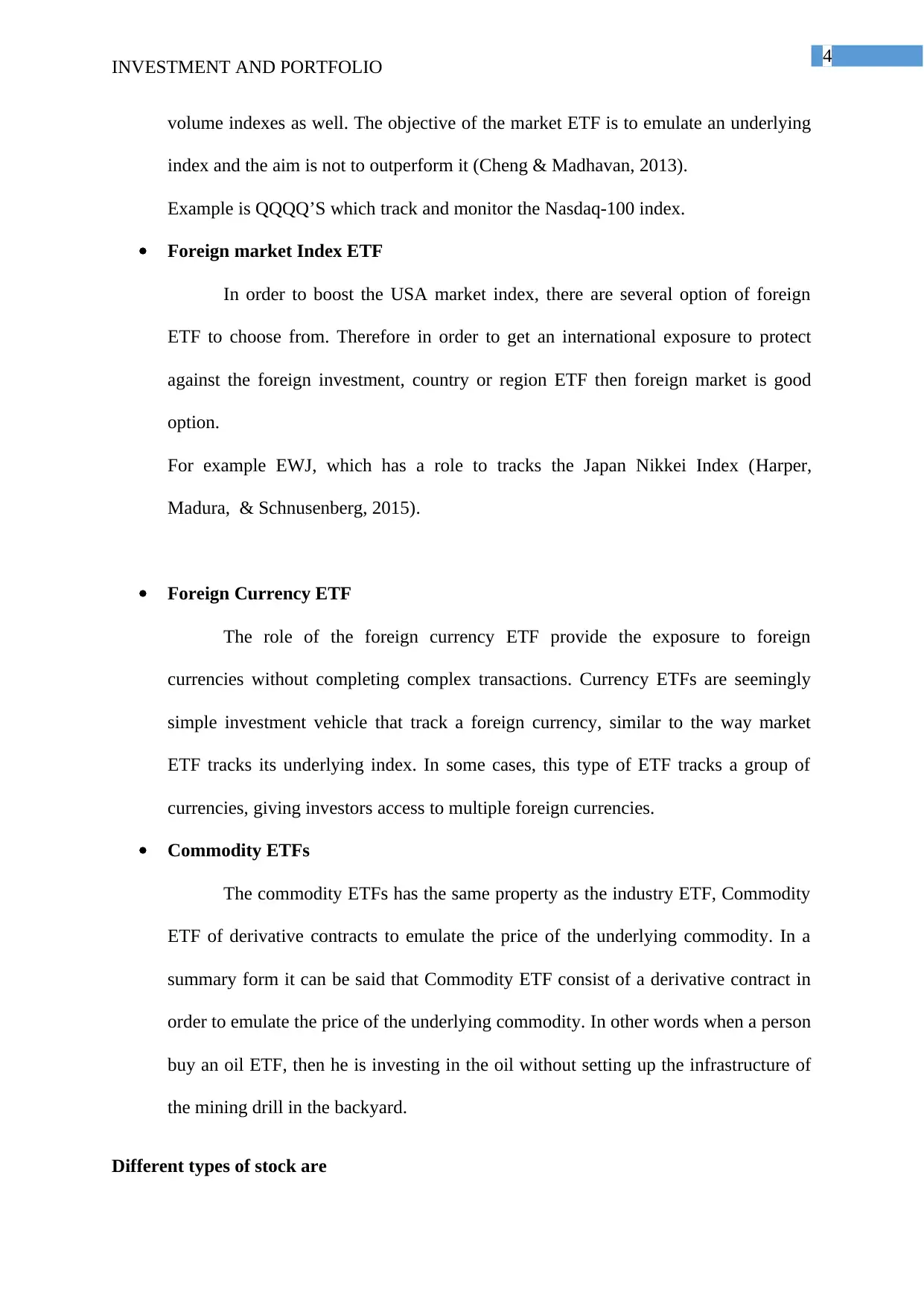
4
INVESTMENT AND PORTFOLIO
volume indexes as well. The objective of the market ETF is to emulate an underlying
index and the aim is not to outperform it (Cheng & Madhavan, 2013).
Example is QQQQ’S which track and monitor the Nasdaq-100 index.
Foreign market Index ETF
In order to boost the USA market index, there are several option of foreign
ETF to choose from. Therefore in order to get an international exposure to protect
against the foreign investment, country or region ETF then foreign market is good
option.
For example EWJ, which has a role to tracks the Japan Nikkei Index (Harper,
Madura, & Schnusenberg, 2015).
Foreign Currency ETF
The role of the foreign currency ETF provide the exposure to foreign
currencies without completing complex transactions. Currency ETFs are seemingly
simple investment vehicle that track a foreign currency, similar to the way market
ETF tracks its underlying index. In some cases, this type of ETF tracks a group of
currencies, giving investors access to multiple foreign currencies.
Commodity ETFs
The commodity ETFs has the same property as the industry ETF, Commodity
ETF of derivative contracts to emulate the price of the underlying commodity. In a
summary form it can be said that Commodity ETF consist of a derivative contract in
order to emulate the price of the underlying commodity. In other words when a person
buy an oil ETF, then he is investing in the oil without setting up the infrastructure of
the mining drill in the backyard.
Different types of stock are
INVESTMENT AND PORTFOLIO
volume indexes as well. The objective of the market ETF is to emulate an underlying
index and the aim is not to outperform it (Cheng & Madhavan, 2013).
Example is QQQQ’S which track and monitor the Nasdaq-100 index.
Foreign market Index ETF
In order to boost the USA market index, there are several option of foreign
ETF to choose from. Therefore in order to get an international exposure to protect
against the foreign investment, country or region ETF then foreign market is good
option.
For example EWJ, which has a role to tracks the Japan Nikkei Index (Harper,
Madura, & Schnusenberg, 2015).
Foreign Currency ETF
The role of the foreign currency ETF provide the exposure to foreign
currencies without completing complex transactions. Currency ETFs are seemingly
simple investment vehicle that track a foreign currency, similar to the way market
ETF tracks its underlying index. In some cases, this type of ETF tracks a group of
currencies, giving investors access to multiple foreign currencies.
Commodity ETFs
The commodity ETFs has the same property as the industry ETF, Commodity
ETF of derivative contracts to emulate the price of the underlying commodity. In a
summary form it can be said that Commodity ETF consist of a derivative contract in
order to emulate the price of the underlying commodity. In other words when a person
buy an oil ETF, then he is investing in the oil without setting up the infrastructure of
the mining drill in the backyard.
Different types of stock are
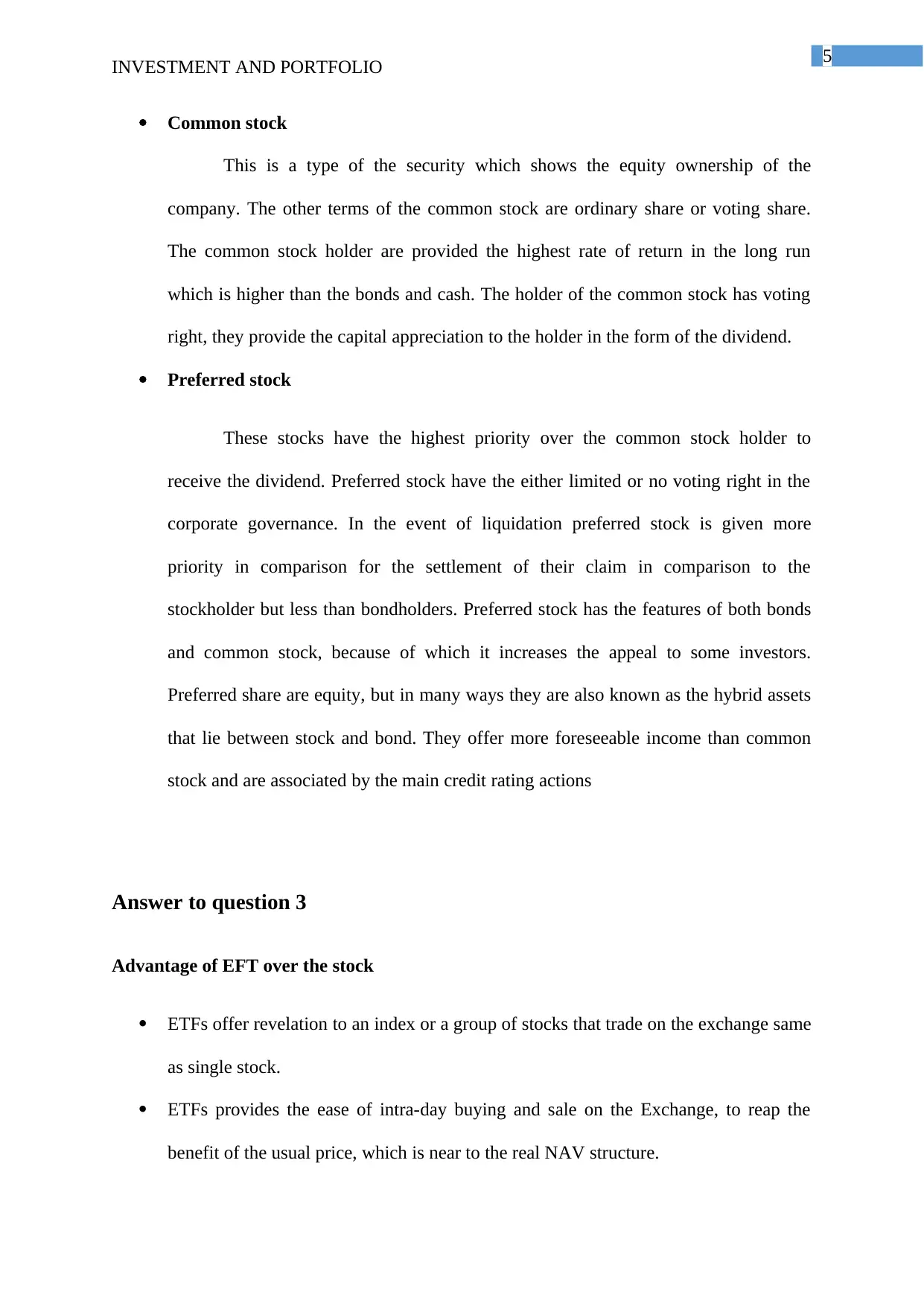
5
INVESTMENT AND PORTFOLIO
Common stock
This is a type of the security which shows the equity ownership of the
company. The other terms of the common stock are ordinary share or voting share.
The common stock holder are provided the highest rate of return in the long run
which is higher than the bonds and cash. The holder of the common stock has voting
right, they provide the capital appreciation to the holder in the form of the dividend.
Preferred stock
These stocks have the highest priority over the common stock holder to
receive the dividend. Preferred stock have the either limited or no voting right in the
corporate governance. In the event of liquidation preferred stock is given more
priority in comparison for the settlement of their claim in comparison to the
stockholder but less than bondholders. Preferred stock has the features of both bonds
and common stock, because of which it increases the appeal to some investors.
Preferred share are equity, but in many ways they are also known as the hybrid assets
that lie between stock and bond. They offer more foreseeable income than common
stock and are associated by the main credit rating actions
Answer to question 3
Advantage of EFT over the stock
ETFs offer revelation to an index or a group of stocks that trade on the exchange same
as single stock.
ETFs provides the ease of intra-day buying and sale on the Exchange, to reap the
benefit of the usual price, which is near to the real NAV structure.
INVESTMENT AND PORTFOLIO
Common stock
This is a type of the security which shows the equity ownership of the
company. The other terms of the common stock are ordinary share or voting share.
The common stock holder are provided the highest rate of return in the long run
which is higher than the bonds and cash. The holder of the common stock has voting
right, they provide the capital appreciation to the holder in the form of the dividend.
Preferred stock
These stocks have the highest priority over the common stock holder to
receive the dividend. Preferred stock have the either limited or no voting right in the
corporate governance. In the event of liquidation preferred stock is given more
priority in comparison for the settlement of their claim in comparison to the
stockholder but less than bondholders. Preferred stock has the features of both bonds
and common stock, because of which it increases the appeal to some investors.
Preferred share are equity, but in many ways they are also known as the hybrid assets
that lie between stock and bond. They offer more foreseeable income than common
stock and are associated by the main credit rating actions
Answer to question 3
Advantage of EFT over the stock
ETFs offer revelation to an index or a group of stocks that trade on the exchange same
as single stock.
ETFs provides the ease of intra-day buying and sale on the Exchange, to reap the
benefit of the usual price, which is near to the real NAV structure.
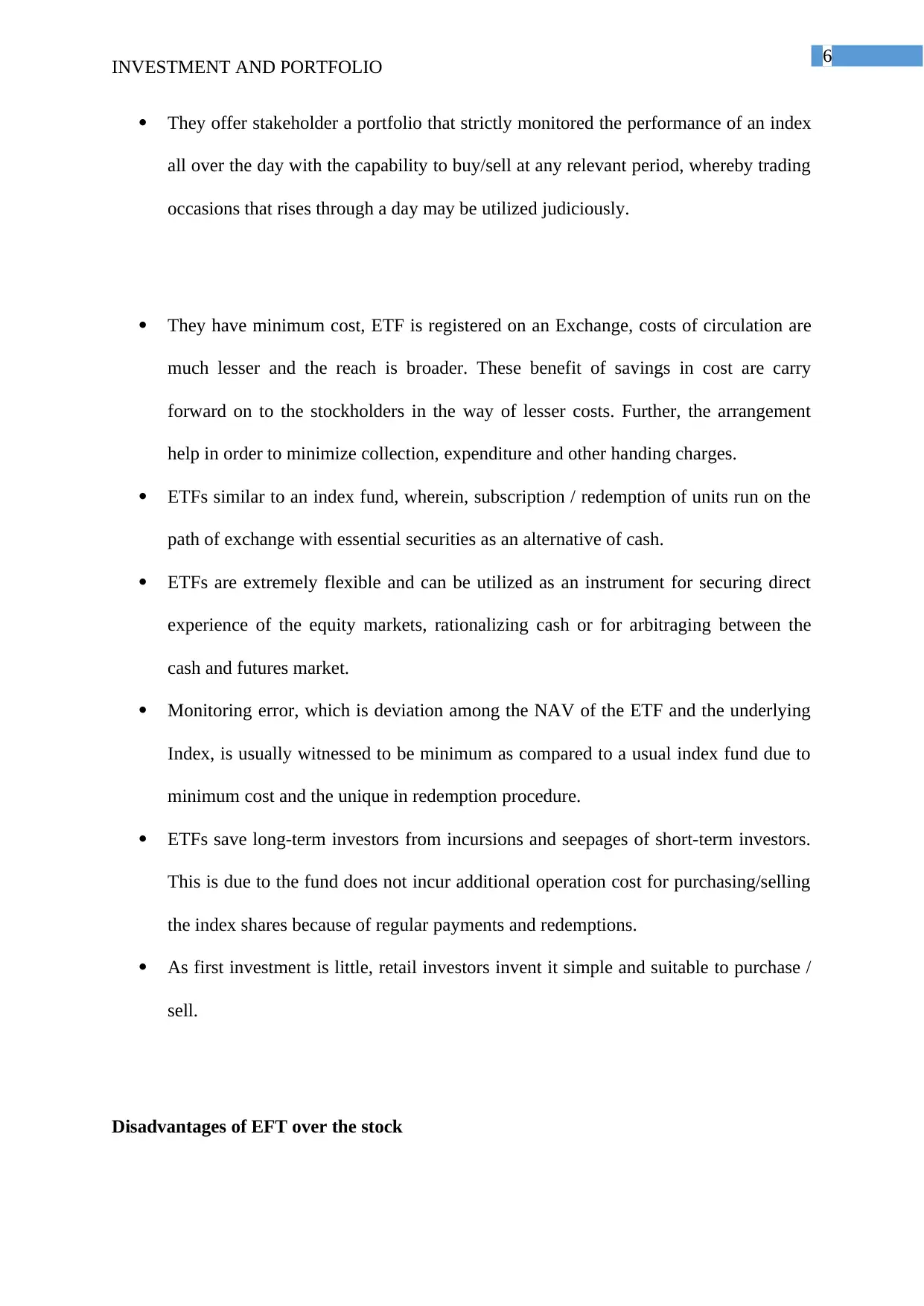
6
INVESTMENT AND PORTFOLIO
They offer stakeholder a portfolio that strictly monitored the performance of an index
all over the day with the capability to buy/sell at any relevant period, whereby trading
occasions that rises through a day may be utilized judiciously.
They have minimum cost, ETF is registered on an Exchange, costs of circulation are
much lesser and the reach is broader. These benefit of savings in cost are carry
forward on to the stockholders in the way of lesser costs. Further, the arrangement
help in order to minimize collection, expenditure and other handing charges.
ETFs similar to an index fund, wherein, subscription / redemption of units run on the
path of exchange with essential securities as an alternative of cash.
ETFs are extremely flexible and can be utilized as an instrument for securing direct
experience of the equity markets, rationalizing cash or for arbitraging between the
cash and futures market.
Monitoring error, which is deviation among the NAV of the ETF and the underlying
Index, is usually witnessed to be minimum as compared to a usual index fund due to
minimum cost and the unique in redemption procedure.
ETFs save long-term investors from incursions and seepages of short-term investors.
This is due to the fund does not incur additional operation cost for purchasing/selling
the index shares because of regular payments and redemptions.
As first investment is little, retail investors invent it simple and suitable to purchase /
sell.
Disadvantages of EFT over the stock
INVESTMENT AND PORTFOLIO
They offer stakeholder a portfolio that strictly monitored the performance of an index
all over the day with the capability to buy/sell at any relevant period, whereby trading
occasions that rises through a day may be utilized judiciously.
They have minimum cost, ETF is registered on an Exchange, costs of circulation are
much lesser and the reach is broader. These benefit of savings in cost are carry
forward on to the stockholders in the way of lesser costs. Further, the arrangement
help in order to minimize collection, expenditure and other handing charges.
ETFs similar to an index fund, wherein, subscription / redemption of units run on the
path of exchange with essential securities as an alternative of cash.
ETFs are extremely flexible and can be utilized as an instrument for securing direct
experience of the equity markets, rationalizing cash or for arbitraging between the
cash and futures market.
Monitoring error, which is deviation among the NAV of the ETF and the underlying
Index, is usually witnessed to be minimum as compared to a usual index fund due to
minimum cost and the unique in redemption procedure.
ETFs save long-term investors from incursions and seepages of short-term investors.
This is due to the fund does not incur additional operation cost for purchasing/selling
the index shares because of regular payments and redemptions.
As first investment is little, retail investors invent it simple and suitable to purchase /
sell.
Disadvantages of EFT over the stock
Paraphrase This Document
Need a fresh take? Get an instant paraphrase of this document with our AI Paraphraser
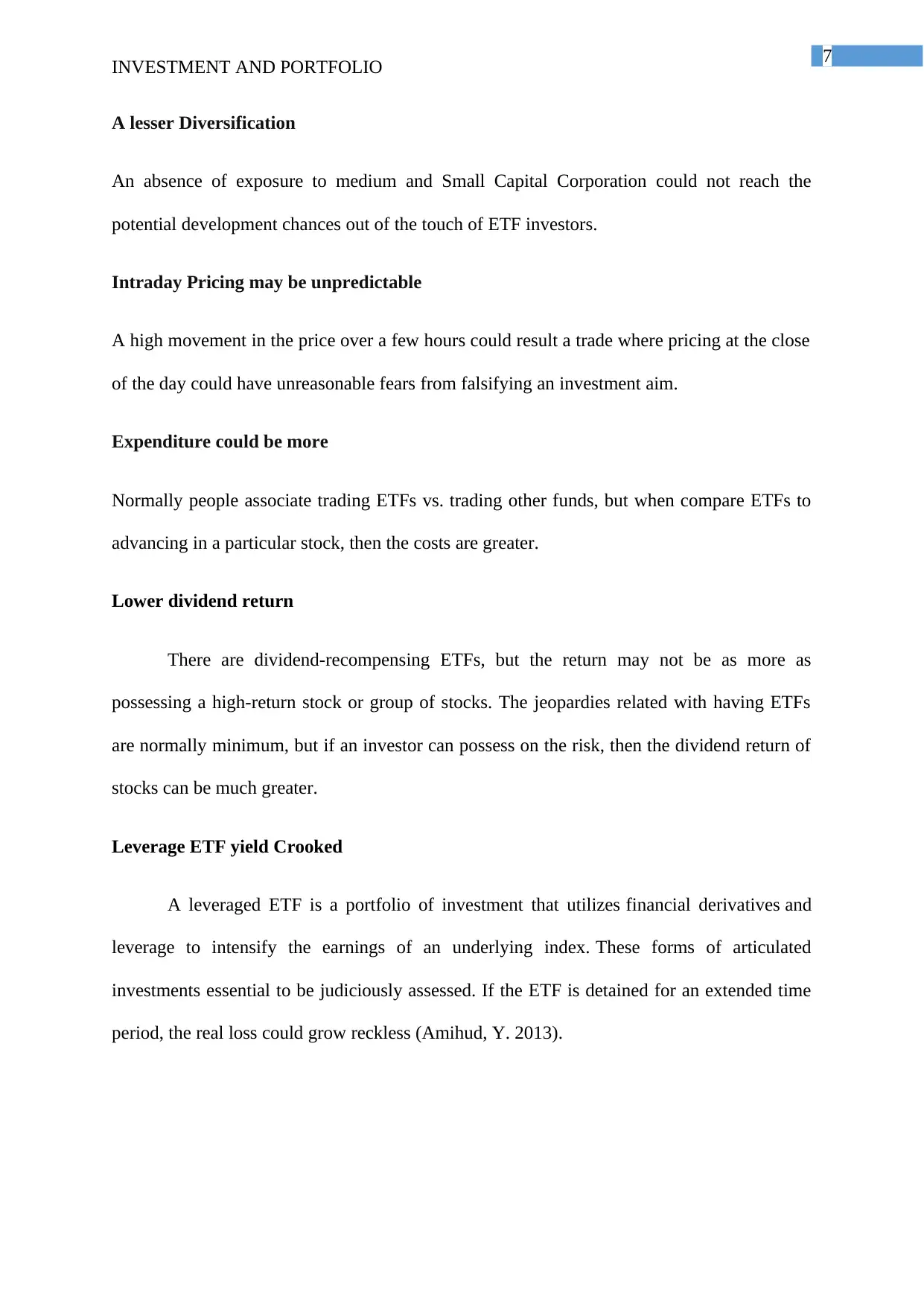
7
INVESTMENT AND PORTFOLIO
A lesser Diversification
An absence of exposure to medium and Small Capital Corporation could not reach the
potential development chances out of the touch of ETF investors.
Intraday Pricing may be unpredictable
A high movement in the price over a few hours could result a trade where pricing at the close
of the day could have unreasonable fears from falsifying an investment aim.
Expenditure could be more
Normally people associate trading ETFs vs. trading other funds, but when compare ETFs to
advancing in a particular stock, then the costs are greater.
Lower dividend return
There are dividend-recompensing ETFs, but the return may not be as more as
possessing a high-return stock or group of stocks. The jeopardies related with having ETFs
are normally minimum, but if an investor can possess on the risk, then the dividend return of
stocks can be much greater.
Leverage ETF yield Crooked
A leveraged ETF is a portfolio of investment that utilizes financial derivatives and
leverage to intensify the earnings of an underlying index. These forms of articulated
investments essential to be judiciously assessed. If the ETF is detained for an extended time
period, the real loss could grow reckless (Amihud, Y. 2013).
INVESTMENT AND PORTFOLIO
A lesser Diversification
An absence of exposure to medium and Small Capital Corporation could not reach the
potential development chances out of the touch of ETF investors.
Intraday Pricing may be unpredictable
A high movement in the price over a few hours could result a trade where pricing at the close
of the day could have unreasonable fears from falsifying an investment aim.
Expenditure could be more
Normally people associate trading ETFs vs. trading other funds, but when compare ETFs to
advancing in a particular stock, then the costs are greater.
Lower dividend return
There are dividend-recompensing ETFs, but the return may not be as more as
possessing a high-return stock or group of stocks. The jeopardies related with having ETFs
are normally minimum, but if an investor can possess on the risk, then the dividend return of
stocks can be much greater.
Leverage ETF yield Crooked
A leveraged ETF is a portfolio of investment that utilizes financial derivatives and
leverage to intensify the earnings of an underlying index. These forms of articulated
investments essential to be judiciously assessed. If the ETF is detained for an extended time
period, the real loss could grow reckless (Amihud, Y. 2013).
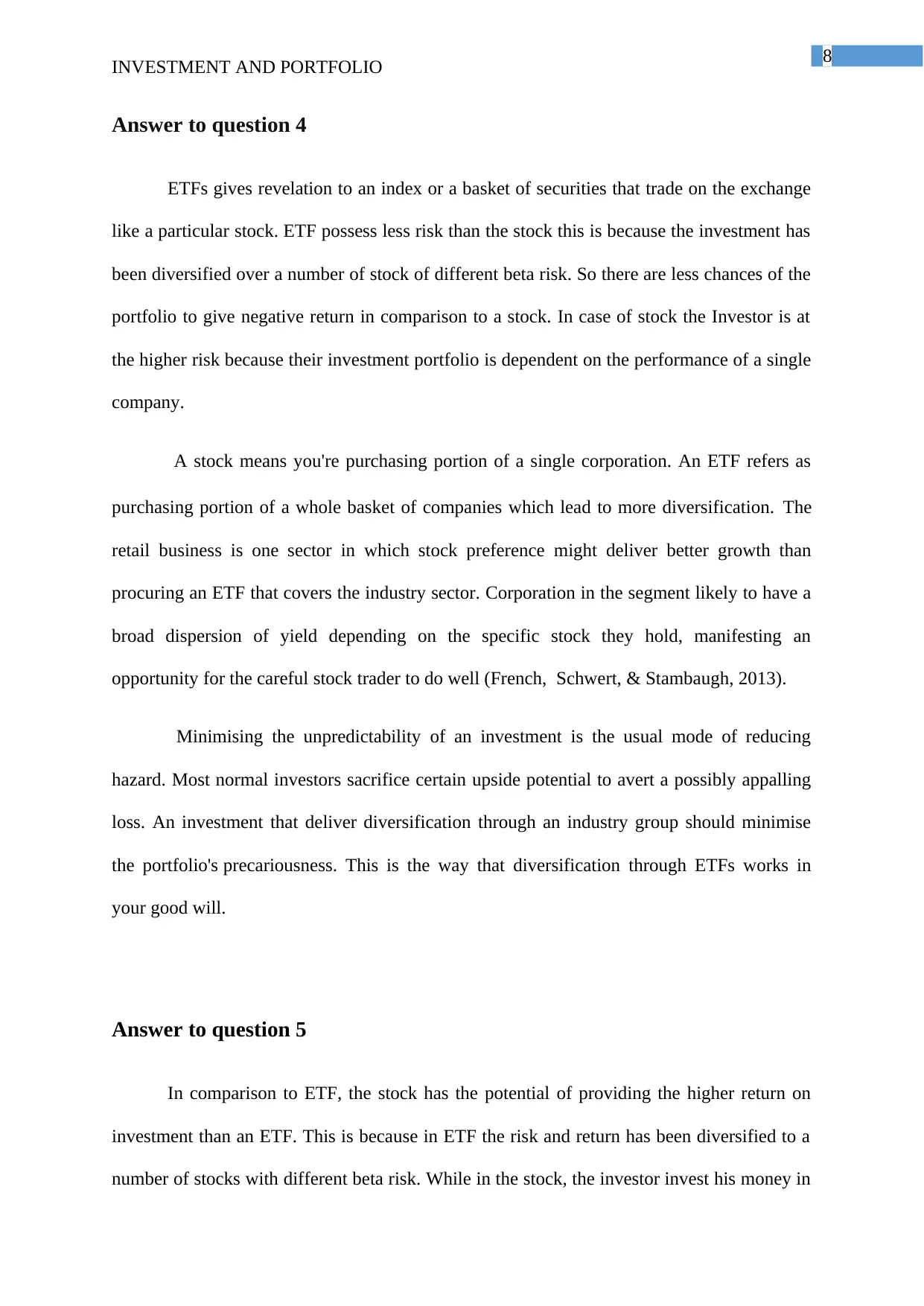
8
INVESTMENT AND PORTFOLIO
Answer to question 4
ETFs gives revelation to an index or a basket of securities that trade on the exchange
like a particular stock. ETF possess less risk than the stock this is because the investment has
been diversified over a number of stock of different beta risk. So there are less chances of the
portfolio to give negative return in comparison to a stock. In case of stock the Investor is at
the higher risk because their investment portfolio is dependent on the performance of a single
company.
A stock means you're purchasing portion of a single corporation. An ETF refers as
purchasing portion of a whole basket of companies which lead to more diversification. The
retail business is one sector in which stock preference might deliver better growth than
procuring an ETF that covers the industry sector. Corporation in the segment likely to have a
broad dispersion of yield depending on the specific stock they hold, manifesting an
opportunity for the careful stock trader to do well (French, Schwert, & Stambaugh, 2013).
Minimising the unpredictability of an investment is the usual mode of reducing
hazard. Most normal investors sacrifice certain upside potential to avert a possibly appalling
loss. An investment that deliver diversification through an industry group should minimise
the portfolio's precariousness. This is the way that diversification through ETFs works in
your good will.
Answer to question 5
In comparison to ETF, the stock has the potential of providing the higher return on
investment than an ETF. This is because in ETF the risk and return has been diversified to a
number of stocks with different beta risk. While in the stock, the investor invest his money in
INVESTMENT AND PORTFOLIO
Answer to question 4
ETFs gives revelation to an index or a basket of securities that trade on the exchange
like a particular stock. ETF possess less risk than the stock this is because the investment has
been diversified over a number of stock of different beta risk. So there are less chances of the
portfolio to give negative return in comparison to a stock. In case of stock the Investor is at
the higher risk because their investment portfolio is dependent on the performance of a single
company.
A stock means you're purchasing portion of a single corporation. An ETF refers as
purchasing portion of a whole basket of companies which lead to more diversification. The
retail business is one sector in which stock preference might deliver better growth than
procuring an ETF that covers the industry sector. Corporation in the segment likely to have a
broad dispersion of yield depending on the specific stock they hold, manifesting an
opportunity for the careful stock trader to do well (French, Schwert, & Stambaugh, 2013).
Minimising the unpredictability of an investment is the usual mode of reducing
hazard. Most normal investors sacrifice certain upside potential to avert a possibly appalling
loss. An investment that deliver diversification through an industry group should minimise
the portfolio's precariousness. This is the way that diversification through ETFs works in
your good will.
Answer to question 5
In comparison to ETF, the stock has the potential of providing the higher return on
investment than an ETF. This is because in ETF the risk and return has been diversified to a
number of stocks with different beta risk. While in the stock, the investor invest his money in

9
INVESTMENT AND PORTFOLIO
a stock, which has the potential to generate return which can beat the market. The investor
take this risk to invest in a particular stock by doing proper research on the company which
he has chosen.
Choosing a stock over an ETF has several advantages like
Investment gain
One of the main advantage of investing in the stock is the opportunity to grow money.
Over time, the stock market inclines to upsurge in value, though the prices of particular
stocks increase and decrease daily.
Dividend income
Some stocks offers gain in kind of a dividend. While not every stocks provides dividends,
those that do provide annual pay to investors.
Ownership
Purchasing shares of stock means captivating on a possession stake in the company. This
means that investing in the stock also provide advantage that are portion of being single
business's owners, Shareholders has the right to vote on company board members and
specific business pronouncements (Fama & French,2013).
Answer to question 6
The two companies to invest in the ETF are iPath global carbon ETN and Direxion
daily MSCI both the company are top performers in providing the highest return in a period
of just 1 year i.e. 100.08% and 59.06 % respectively.
INVESTMENT AND PORTFOLIO
a stock, which has the potential to generate return which can beat the market. The investor
take this risk to invest in a particular stock by doing proper research on the company which
he has chosen.
Choosing a stock over an ETF has several advantages like
Investment gain
One of the main advantage of investing in the stock is the opportunity to grow money.
Over time, the stock market inclines to upsurge in value, though the prices of particular
stocks increase and decrease daily.
Dividend income
Some stocks offers gain in kind of a dividend. While not every stocks provides dividends,
those that do provide annual pay to investors.
Ownership
Purchasing shares of stock means captivating on a possession stake in the company. This
means that investing in the stock also provide advantage that are portion of being single
business's owners, Shareholders has the right to vote on company board members and
specific business pronouncements (Fama & French,2013).
Answer to question 6
The two companies to invest in the ETF are iPath global carbon ETN and Direxion
daily MSCI both the company are top performers in providing the highest return in a period
of just 1 year i.e. 100.08% and 59.06 % respectively.
Secure Best Marks with AI Grader
Need help grading? Try our AI Grader for instant feedback on your assignments.
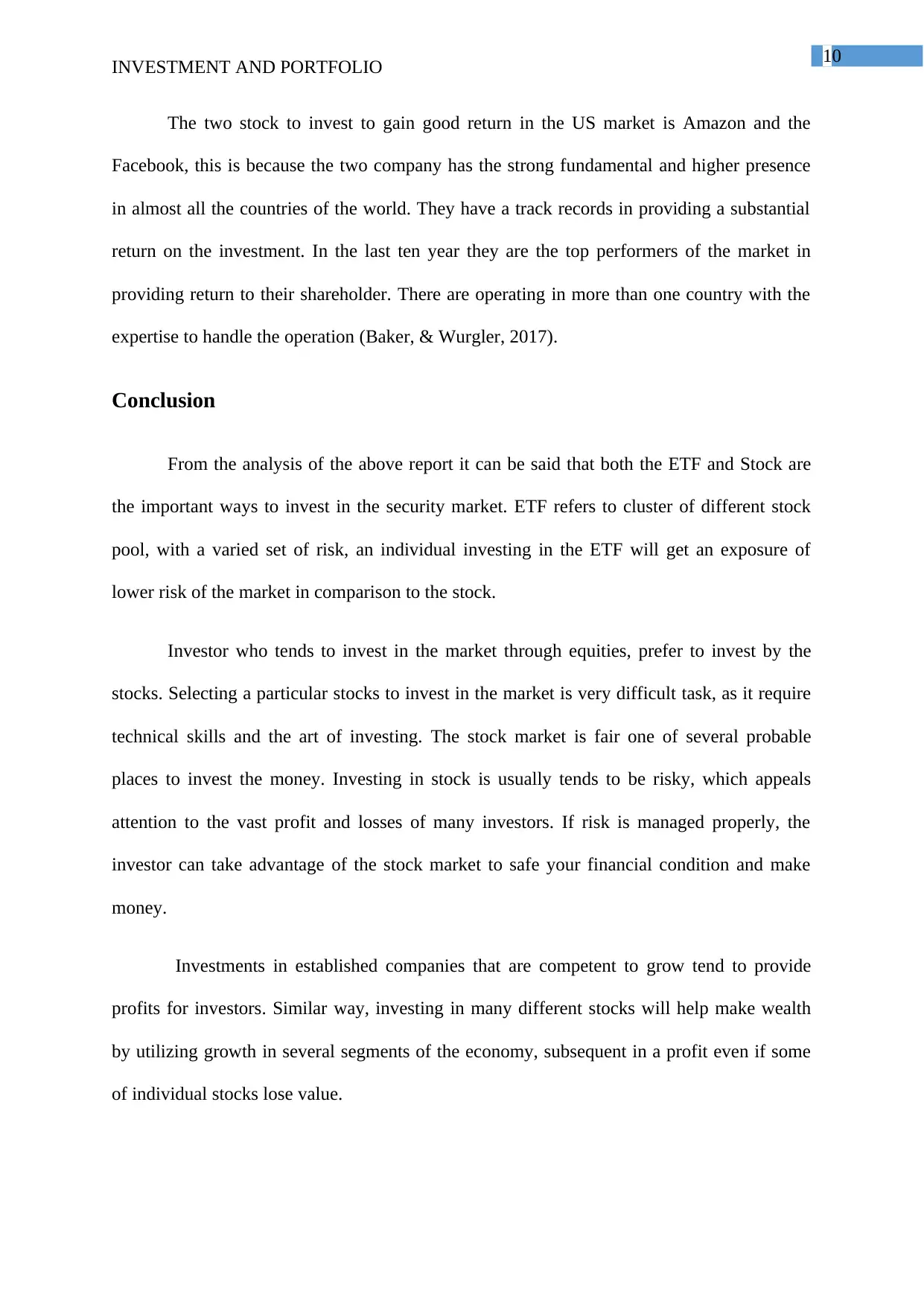
10
INVESTMENT AND PORTFOLIO
The two stock to invest to gain good return in the US market is Amazon and the
Facebook, this is because the two company has the strong fundamental and higher presence
in almost all the countries of the world. They have a track records in providing a substantial
return on the investment. In the last ten year they are the top performers of the market in
providing return to their shareholder. There are operating in more than one country with the
expertise to handle the operation (Baker, & Wurgler, 2017).
Conclusion
From the analysis of the above report it can be said that both the ETF and Stock are
the important ways to invest in the security market. ETF refers to cluster of different stock
pool, with a varied set of risk, an individual investing in the ETF will get an exposure of
lower risk of the market in comparison to the stock.
Investor who tends to invest in the market through equities, prefer to invest by the
stocks. Selecting a particular stocks to invest in the market is very difficult task, as it require
technical skills and the art of investing. The stock market is fair one of several probable
places to invest the money. Investing in stock is usually tends to be risky, which appeals
attention to the vast profit and losses of many investors. If risk is managed properly, the
investor can take advantage of the stock market to safe your financial condition and make
money.
Investments in established companies that are competent to grow tend to provide
profits for investors. Similar way, investing in many different stocks will help make wealth
by utilizing growth in several segments of the economy, subsequent in a profit even if some
of individual stocks lose value.
INVESTMENT AND PORTFOLIO
The two stock to invest to gain good return in the US market is Amazon and the
Facebook, this is because the two company has the strong fundamental and higher presence
in almost all the countries of the world. They have a track records in providing a substantial
return on the investment. In the last ten year they are the top performers of the market in
providing return to their shareholder. There are operating in more than one country with the
expertise to handle the operation (Baker, & Wurgler, 2017).
Conclusion
From the analysis of the above report it can be said that both the ETF and Stock are
the important ways to invest in the security market. ETF refers to cluster of different stock
pool, with a varied set of risk, an individual investing in the ETF will get an exposure of
lower risk of the market in comparison to the stock.
Investor who tends to invest in the market through equities, prefer to invest by the
stocks. Selecting a particular stocks to invest in the market is very difficult task, as it require
technical skills and the art of investing. The stock market is fair one of several probable
places to invest the money. Investing in stock is usually tends to be risky, which appeals
attention to the vast profit and losses of many investors. If risk is managed properly, the
investor can take advantage of the stock market to safe your financial condition and make
money.
Investments in established companies that are competent to grow tend to provide
profits for investors. Similar way, investing in many different stocks will help make wealth
by utilizing growth in several segments of the economy, subsequent in a profit even if some
of individual stocks lose value.
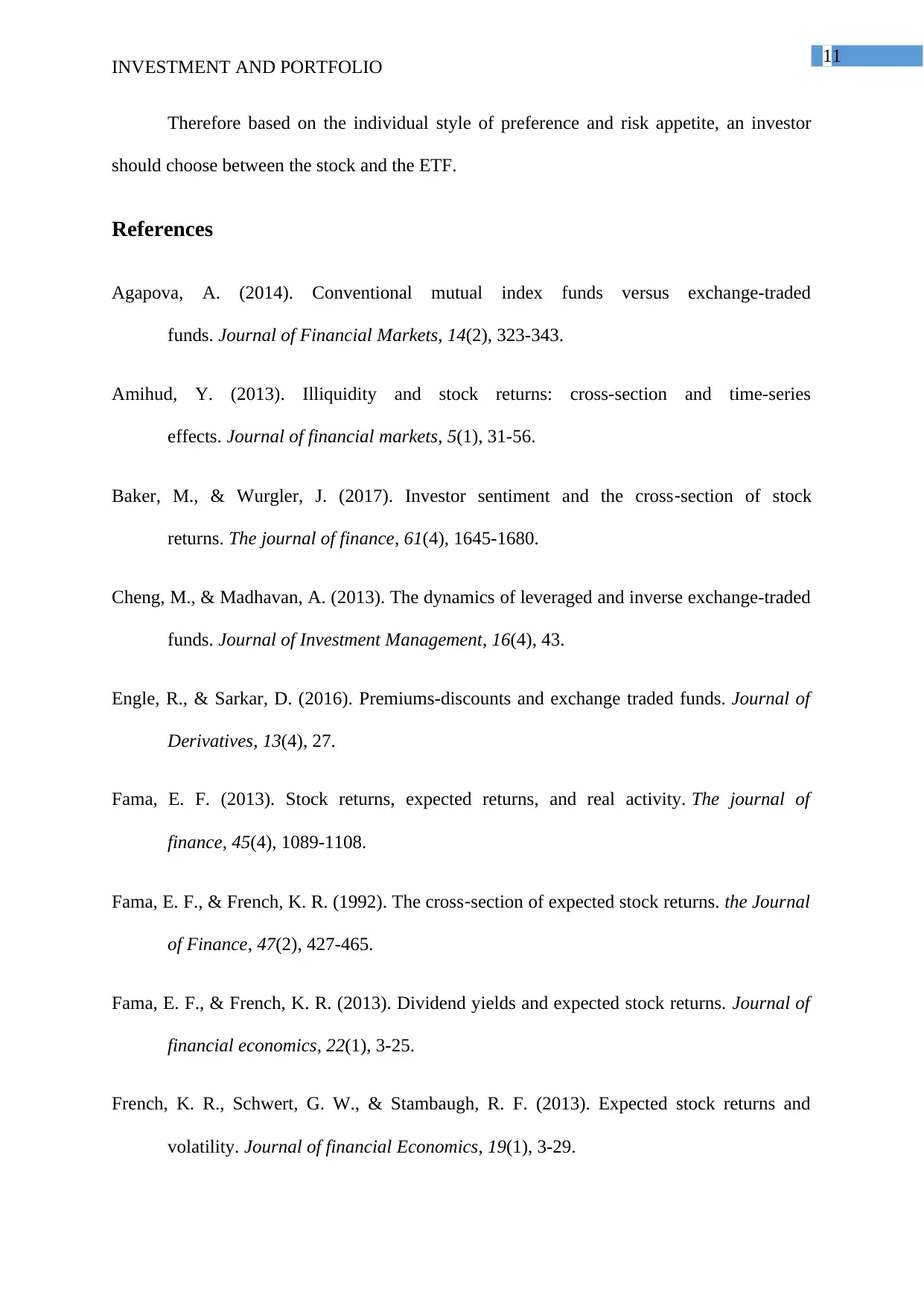
11
INVESTMENT AND PORTFOLIO
Therefore based on the individual style of preference and risk appetite, an investor
should choose between the stock and the ETF.
References
Agapova, A. (2014). Conventional mutual index funds versus exchange-traded
funds. Journal of Financial Markets, 14(2), 323-343.
Amihud, Y. (2013). Illiquidity and stock returns: cross-section and time-series
effects. Journal of financial markets, 5(1), 31-56.
Baker, M., & Wurgler, J. (2017). Investor sentiment and the cross‐section of stock
returns. The journal of finance, 61(4), 1645-1680.
Cheng, M., & Madhavan, A. (2013). The dynamics of leveraged and inverse exchange-traded
funds. Journal of Investment Management, 16(4), 43.
Engle, R., & Sarkar, D. (2016). Premiums-discounts and exchange traded funds. Journal of
Derivatives, 13(4), 27.
Fama, E. F. (2013). Stock returns, expected returns, and real activity. The journal of
finance, 45(4), 1089-1108.
Fama, E. F., & French, K. R. (1992). The cross‐section of expected stock returns. the Journal
of Finance, 47(2), 427-465.
Fama, E. F., & French, K. R. (2013). Dividend yields and expected stock returns. Journal of
financial economics, 22(1), 3-25.
French, K. R., Schwert, G. W., & Stambaugh, R. F. (2013). Expected stock returns and
volatility. Journal of financial Economics, 19(1), 3-29.
INVESTMENT AND PORTFOLIO
Therefore based on the individual style of preference and risk appetite, an investor
should choose between the stock and the ETF.
References
Agapova, A. (2014). Conventional mutual index funds versus exchange-traded
funds. Journal of Financial Markets, 14(2), 323-343.
Amihud, Y. (2013). Illiquidity and stock returns: cross-section and time-series
effects. Journal of financial markets, 5(1), 31-56.
Baker, M., & Wurgler, J. (2017). Investor sentiment and the cross‐section of stock
returns. The journal of finance, 61(4), 1645-1680.
Cheng, M., & Madhavan, A. (2013). The dynamics of leveraged and inverse exchange-traded
funds. Journal of Investment Management, 16(4), 43.
Engle, R., & Sarkar, D. (2016). Premiums-discounts and exchange traded funds. Journal of
Derivatives, 13(4), 27.
Fama, E. F. (2013). Stock returns, expected returns, and real activity. The journal of
finance, 45(4), 1089-1108.
Fama, E. F., & French, K. R. (1992). The cross‐section of expected stock returns. the Journal
of Finance, 47(2), 427-465.
Fama, E. F., & French, K. R. (2013). Dividend yields and expected stock returns. Journal of
financial economics, 22(1), 3-25.
French, K. R., Schwert, G. W., & Stambaugh, R. F. (2013). Expected stock returns and
volatility. Journal of financial Economics, 19(1), 3-29.
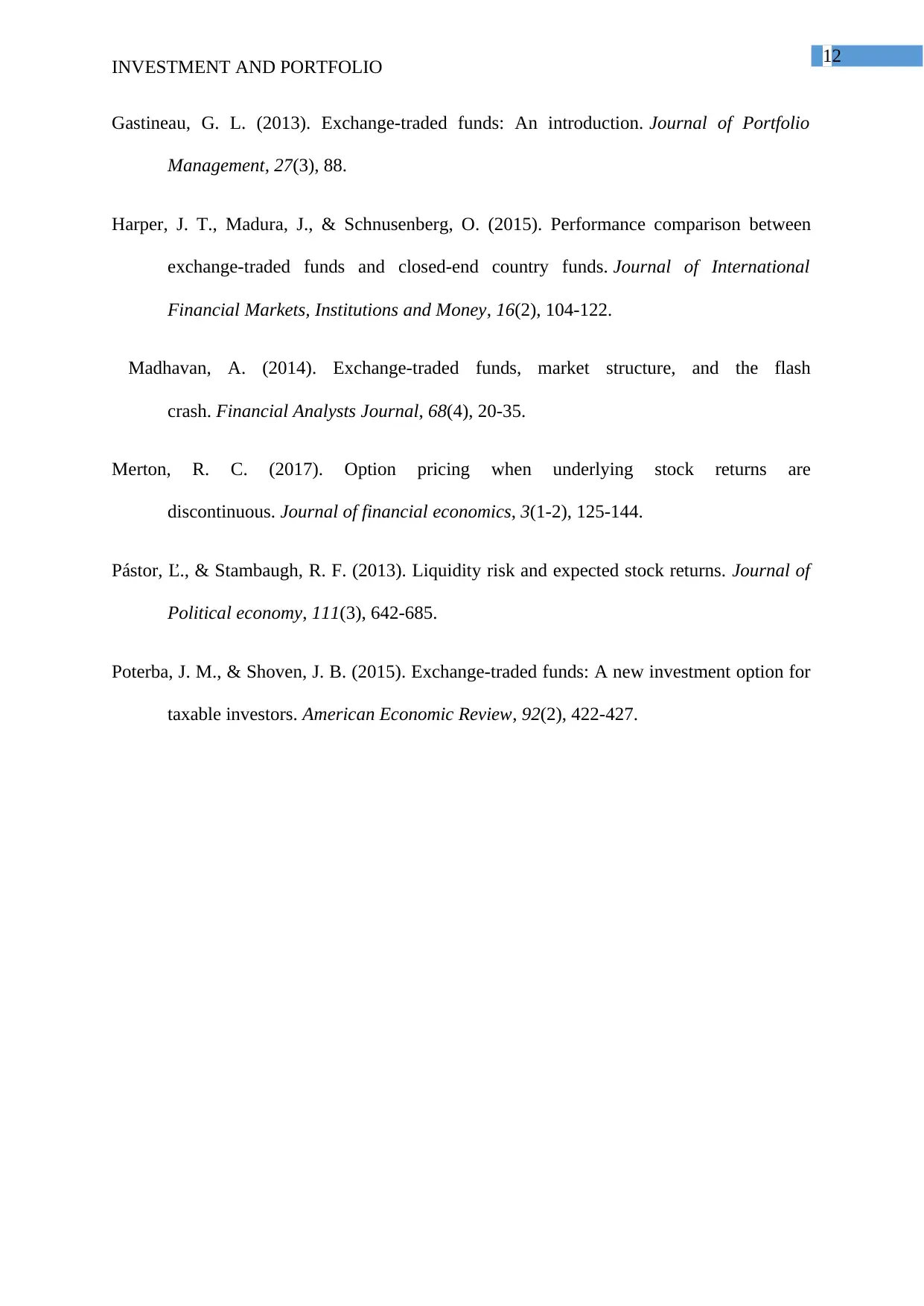
12
INVESTMENT AND PORTFOLIO
Gastineau, G. L. (2013). Exchange-traded funds: An introduction. Journal of Portfolio
Management, 27(3), 88.
Harper, J. T., Madura, J., & Schnusenberg, O. (2015). Performance comparison between
exchange-traded funds and closed-end country funds. Journal of International
Financial Markets, Institutions and Money, 16(2), 104-122.
Madhavan, A. (2014). Exchange-traded funds, market structure, and the flash
crash. Financial Analysts Journal, 68(4), 20-35.
Merton, R. C. (2017). Option pricing when underlying stock returns are
discontinuous. Journal of financial economics, 3(1-2), 125-144.
Pástor, Ľ., & Stambaugh, R. F. (2013). Liquidity risk and expected stock returns. Journal of
Political economy, 111(3), 642-685.
Poterba, J. M., & Shoven, J. B. (2015). Exchange-traded funds: A new investment option for
taxable investors. American Economic Review, 92(2), 422-427.
INVESTMENT AND PORTFOLIO
Gastineau, G. L. (2013). Exchange-traded funds: An introduction. Journal of Portfolio
Management, 27(3), 88.
Harper, J. T., Madura, J., & Schnusenberg, O. (2015). Performance comparison between
exchange-traded funds and closed-end country funds. Journal of International
Financial Markets, Institutions and Money, 16(2), 104-122.
Madhavan, A. (2014). Exchange-traded funds, market structure, and the flash
crash. Financial Analysts Journal, 68(4), 20-35.
Merton, R. C. (2017). Option pricing when underlying stock returns are
discontinuous. Journal of financial economics, 3(1-2), 125-144.
Pástor, Ľ., & Stambaugh, R. F. (2013). Liquidity risk and expected stock returns. Journal of
Political economy, 111(3), 642-685.
Poterba, J. M., & Shoven, J. B. (2015). Exchange-traded funds: A new investment option for
taxable investors. American Economic Review, 92(2), 422-427.
1 out of 13
Related Documents
Your All-in-One AI-Powered Toolkit for Academic Success.
+13062052269
info@desklib.com
Available 24*7 on WhatsApp / Email
![[object Object]](/_next/static/media/star-bottom.7253800d.svg)
Unlock your academic potential
© 2024 | Zucol Services PVT LTD | All rights reserved.





